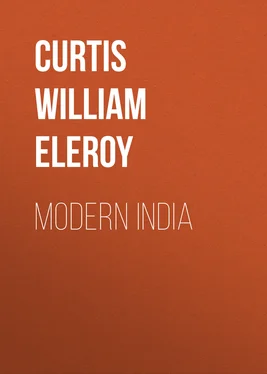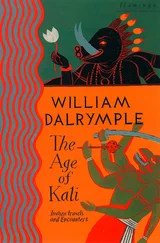William Curtis - Modern India
Здесь есть возможность читать онлайн «William Curtis - Modern India» — ознакомительный отрывок электронной книги совершенно бесплатно, а после прочтения отрывка купить полную версию. В некоторых случаях можно слушать аудио, скачать через торрент в формате fb2 и присутствует краткое содержание. Жанр: Путешествия и география, История, foreign_edu, foreign_antique, foreign_prose, на английском языке. Описание произведения, (предисловие) а так же отзывы посетителей доступны на портале библиотеки ЛибКат.
- Название:Modern India
- Автор:
- Жанр:
- Год:неизвестен
- ISBN:нет данных
- Рейтинг книги:4 / 5. Голосов: 1
-
Избранное:Добавить в избранное
- Отзывы:
-
Ваша оценка:
- 80
- 1
- 2
- 3
- 4
- 5
Modern India: краткое содержание, описание и аннотация
Предлагаем к чтению аннотацию, описание, краткое содержание или предисловие (зависит от того, что написал сам автор книги «Modern India»). Если вы не нашли необходимую информацию о книге — напишите в комментариях, мы постараемся отыскать её.
Modern India — читать онлайн ознакомительный отрывок
Ниже представлен текст книги, разбитый по страницам. Система сохранения места последней прочитанной страницы, позволяет с удобством читать онлайн бесплатно книгу «Modern India», без необходимости каждый раз заново искать на чём Вы остановились. Поставьте закладку, и сможете в любой момент перейти на страницу, на которой закончили чтение.
Интервал:
Закладка:
VICTORIA RAILWAY STATION–BOMBAY
It is a vast building of Italian Gothic, with oriental towers and pinnacles, elaborately decorated with sculpture and carving, and a large central dome surmounted by a huge bronze figure of Progress. The architect was Mr. F. W. Stevens, a Bombay engineer; it was finished in 1888 at a cost of $2,500,000, and the wood carving, the tiles, the ornamental iron and brass railings, the grills for the ticket offices, the restaurant and refreshment rooms, the balustrades for the grand staircases, are all the work of the students of the Bombay School of Art, which gives it additional interest, although critics have contended that the architecture and decorations are too ornate for the purpose for which it is used.
Wilson College, one of the most imposing of the long line of buildings, is a memorial to a great Scotch missionary who lived a strenuous and useful life and impressed his principles and his character upon the people of India in a remarkable manner. He was famous for his common sense and accurate judgment; and till the end of his days retained the respect and confidence of every class of the community, from the viceroy and the council of state down to the coolies that sweep the streets. All of them knew and loved Dr. Wilson, and although he never ceased to preach the gospel of Christ, his Master, with the energy, zeal and plain speaking that is characteristic of Scotchmen, the Hindus, Mohammedans, Parsees, Jains, Jews and every other sect admired and encouraged him as much as those of his own faith.
One-fourth of all these buildings were presented to the city by rich and patriotic residents, most of them Parsees and Hindus. The Sailors' Home was the gift of the Maharajah of Baroda; University Hall was founded by Sir Cowasjee Jehangir Readymoney, who also built Elphinstone College. He placed the great fountain in front of the cathedral, and, although a Parsee, built the spire on the Church of St. John the Evangelist.
Mr. Dharmsala, another Parsee, built the Ophthalmic Hospital and the European Strangers' Home and put drinking fountains about the town. David Sassoon, a Persian Jew, founded the Mechanics' Institute, and his brother, Sir Albert Sassoon, built the tower of the Elphinstone High School. Mr. Premchand Raichand built the university library and clock tower in memory of his mother. Sir Jamsetji Jijibhal gave the school of art and the Parsee Benevolent Institute; the sons of Jarahji Parak erected the almshouse. Mr. Rustam Jamshidji founded the Hospital for Women, the East India Company built the Town Hall and other men gave other buildings with the greatest degree of public spirit and patriotism I have ever seen displayed in any town. The guidebook says that during the last quarter of a century patriotic residents of Bombay, mostly natives, have given more than $5,000,000 for public edifices. It is a new form for the expression of patriotism that might be encouraged in the United States.
Several statues were also gifts to the city; that of Queen Victoria, which is one of the finest I have ever seen, having been erected by the Maharajah of Baroda, and that of the Prince of Wales by Sir Edward Beohm. These are the best, but there are several others. Queen Victoria's monument, which stands in the most prominent plaza, where the busiest thoroughfares meet, represents that good woman sitting upon her throne under a lofty Gothic canopy of marble. The carving is elaborate and exquisite. In the center of the canopy appears the Star of India, and above it the Rose of England, united with the Lotus of India, with the mottoes of both countries intertwined–"God and My Right" and "Heaven's Light Our Guide."
Queen Victoria was no stranger to the people of India. They felt a personal relationship with their empress, and many touching incidents are told that have occurred from time to time to illustrate the affection of the Hindus for her. They were taught to call her "The Good Lady of England," and almost every mail, while she was living, carried letters from India to London bearing that address. They came mostly from Hindu women who had learned of her goodness, sympathy and benevolence and hired public scribes at the market places to tell her of their sufferings and wrongs.
In the center of another plaza facing a street called Rampart row, which is lined by lofty buildings containing the best retail shops in town, is a figure of Edward VII. in bronze, on horseback, presented by a local merchant. Near the cathedral is a statute to Lord Cornwallis, who was governor general of India in 1786, and, as the inscription informs us, died at Ghazipur, Oct. 5, 1805. This was erected by the merchants of Bombay, who paid a similar honor to the Marquis of Wellesley, younger brother of the Duke of Wellington, who was also governor general during the days of the East India Company, and did a great deal for the country. He was given a purse of $100,000, and his statue was erected in Bombay, but he died unhappy because the king refused to create him Duke of Hindustan, the only honor that would have satisfied his soul. There are several fine libraries in Bombay, and the Asiatic Society, which has existed since the beginning of the nineteenth century, has one of the largest and most valuable collections of oriental literature in existence.
For three miles and a half the boulevard, and its several branches are bounded by charming residences, which overlook the bay and the roofs of the city. Malabar Point at the end of the drive, the extreme end of the island upon which Bombay is built, is the government house, the residence of the Lord Lamington, who represents King Edward VII. in this beautiful city. It is a series of bungalows, with large, cool rooms and deep verandas, shaded by immense trees and luxurious vines, and has accommodations altogether for about 100 people. The staff of the governor is quite large. He has all kinds of aides-de-camp, secretaries and attaches, and maintains quite a little court. Indeed, his quarters, his staff and his style of living are much more pretentious than those of the President of the United States, and his salary is quite as large. Everywhere he goes he is escorted by a bodyguard of splendid looking native soldiers in scarlet uniforms, big turbans and long spears. They are Sikhs, from the north of India, the greatest fighters in the empire, men of large stature, military bearing and unswerving loyalty to the British crown, and when the Governor of Bombay drives in to his office in the morning or drives back again to his lovely home at night, his carriage is surrounded by a squad of those tawny warriors, who ride as well as they look.
About half-way on the road to the government house is the Gymkhana, and I venture to say that nobody who has not been in India can guess what that means. And if you want another conundrum, what is a chotohazree? It is customary for smart people to have their chotohazree at the Gymkhana, and I think that you would be pleased to join them after taking the beautiful drive which leads to the place. Nobody knows what the word was derived from, but it is used to describe a country club–a bungalow hidden under a beautiful grove on the brow of a cliff that overhangs the bay–with all of the appurtenances, golf links, tennis courts, cricket grounds, racquet courts and indoor gymnasium, and everybody stops there on their afternoon drive to have chotohazree, which is the local term for afternoon tea and for early morning coffee.
There are peculiar customs in Bombay. The proper time for making visits everywhere in India is between 11 a. m. and 1:30 p. m., and fashionable ladies are always at home between those hours and seldom at any other. It seems unnatural, because they are the hottest of the day. One would think that common sense as well as comfort would induce people to stay at home at noon and make themselves as cool as possible. In other tropical countries these are the hours of the siesta, the noonday nap, which is as common and as necessary as breakfast or dinner, and none but a lunatic would think of calling upon a friend after 11 in the morning or before 3 in the afternoon. It would be as ridiculous as to return a social visit at 3 or 4 o'clock in the morning, and the same reasons which govern that custom ought to apply in India as well as in Egypt, Cuba or Brazil. But here ladies put on their best gowns, order their carriages, take their card cases, and start out in the burning noontide glare to return visits and make formal dinner and party calls. Strangers are expected to do the same, and if you have letters of introduction you are expected to present them during those hours, and not at any other time. In the cool of the day, after 5 o'clock, everybody who owns or can hire a carriage goes out to drive, and usually stops at the Gymkhana in the country or at the Yacht Club in the city for chotohazree. It is a good custom to admit women to clubs as they do here. The wives and daughters of members have every privilege, and can give tea parties and luncheons in the clubhouses, while on certain evenings of the week a band is brought from the military barracks and everybody of any account in European society is expected to be present. Tables are spread over the lawn, and are engaged in advance by ladies, who sit behind them, receive visits and pour tea just as they would do in their own houses. It is a very pleasant custom.
Читать дальшеИнтервал:
Закладка:
Похожие книги на «Modern India»
Представляем Вашему вниманию похожие книги на «Modern India» списком для выбора. Мы отобрали схожую по названию и смыслу литературу в надежде предоставить читателям больше вариантов отыскать новые, интересные, ещё непрочитанные произведения.
Обсуждение, отзывы о книге «Modern India» и просто собственные мнения читателей. Оставьте ваши комментарии, напишите, что Вы думаете о произведении, его смысле или главных героях. Укажите что конкретно понравилось, а что нет, и почему Вы так считаете.












